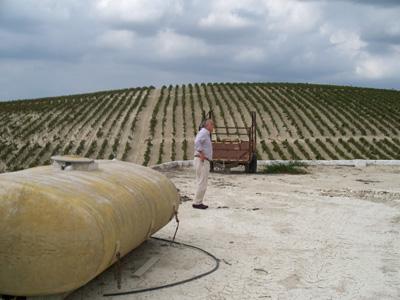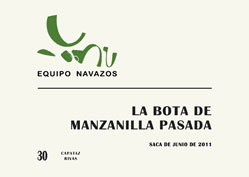Big News for Sherry
& La Bota Revisited
La Bota Fino #27
Manzanilla Pasada #30
& Sherry, Manzanilla & Montilla
Over the last year, the Sherry landscape in this country has changed greatly. Next week promises to impact Sherry in the U.S. in a huge way.
Two related events happening next week are almost unprecedented. First, Peter Liem's and Jesús Barquin's book Sherry, Manzanilla & Montilla will finally be released. You can buy advance copies today. (Please see below.)
There hasn't been a widely available new Sherry book for decades. Peter Liem is one of the sharpest palates in the business. He's been traveling to the Sherry region (and Montilla) for the past fourteen years. Jesús Barquin is a Sherry expert and professor of criminology at the University of Granada. With Eduardo Ojeda, he's one half of Equipo Navazos' ultra-limited La Bota Sherries. Together, they bring a level of knowledge about the region that's unparalleled.
 |
| Eduardo Ojeda in the Macharnudo Alto Vineyard. |
The other event is that veritable deluge of Sherry that will flow through NYC next week. An army of Sherry's best producers will be in town with some of their best bottles in hand. It's easily the most epic Sherry event ever to hit the U.S.
For people interested or just curious about Sherry, I strongly encourage you to attend some of the dinners taking place next week. You can check them out at the Sherryfest website. This is a great opportunity to sit down with top Sherry producers or the emminently wise Peter Liem to drink some great bottles with thoughtful food pairings.
My understanding of Sherry is immensely indebted to both Peter Liem and Jesús Barquin. One of their most eye-opening insights that they have taught me is that Finos (and Manzanillas) not only age well, but often demand aging. This is in contrast to the popular belief that Finos and Manzanillas need to be drunk very fresh, by around six months after bottling.
I've seen this first hand with bottles like Valdespino's Inocente and La Bota's Finos and Manzanillas that have been up to six years old. Often these wines need at least a year to start really showing well.
With this in mind, we intentionally went long on La Bota's Fino #27 (bottled March 2011) and Manzanilla Pasada #30 (bottled June 2011) to allow them to acquire some age.
Yup - we cellared these for free to prove a point. And to provide for a truly unique Sherry experience.
Both bottles are only now hitting their stride, though I'd really have no fear in aging them longer. There are stories of both of Inocente and La Guita's Manzanilla (the sources for the wines) aging thirty years after bottling.
For those thirsty for knowledge AND Sherry, consider the book-and-bottle 3-pack: You'll get a copy of Sherry, Manzanilla & Montilla, one bottle of Fino #27 and one bottle of Manzanilla Pasada #30.
Sherry is a beverage of details, so please see below for a full write-up on the wines and an overview of La Bota.
 |
La Bota
The history of Equipo Navazos is fascinating - and you can read our entire profile and the story of La Bota here - but before going any further it's worth mentioning that this project wasn't originally intended to be commercialized or make money.
It came, rather, out of two sherry lovers' desire to get their hands on some extraordinary Amontillado, and a "team" that went on to essentially select the most extraordinary, compellingly singular butts from what are already superlative Sherry soleras.
This hunt for singularity, for particularities, is extremely important in the context of the region, where the solera system is typically meant to promote standardization. Equipo Navazos' rigorous selection process certainly shows in the wines, which possess a spellbinding intensity, elegance and texture.
Fino #27
For the Fino #27, Eduardo Ojeda and Jesús Barquín (the two whose palates are behind La Bota) selected their favorite amongst the 69 butts that make up Valdespino's famed Inocente solera, a Fino sourced from Macharnudo Alto, a single vineyard that boasts the highest altitude in Jerez and that's famed for the purity of its chalk soils.
Valdespino's Inocente Solera is around 11 years old, and following Equipo Navazos' standard procedure, it's bottled with only the slightest filtration. Both of these qualities are unusual: the majority of Finos clock in at three to five years of age and are aggressively filtered.
The resulting wine shows a finessed complexity with a fascinating texture that's buttery and silken, with gently oxidative notes along with candied citrus, a salty tang and defiantly long finish.
Manzanilla #30
Equipo Navazos' Manzanilla Pasada #30 originates from a solera founded in 1986 at the Bodegas La Guita. This is the same solera that produced the #10 and #20, for you die-hard Equipo fans.
As Jesús Barquin said to me last summer, "This is a very special wine. I don't know of anything else like it in Sherry country." Describing the wine is complicated; recognizing its stature is not.
 |
The wine from this solera was never commercialized simply because the market was, at the time, moving toward light and crisp Manzanillas. However, the "Capataz" (the bodega foreman) couldn't let Manzanilla of such incredible quality go, and he maintained the solera by drawing small amounts of wine and refreshing it to keep the flor (yeasts) alive.
Today, when most Manzanillas are between three to four years old, the #30 boasts an average age of 15 years.
The result is an epic bottle of Sherry, a wine that is nearly impossible to describe - and just as impossible not to appreciate. There is just more of everything.
This is a much deserved moment for Sherry, one of the world's great and unique wines. For a region that's struggled in recent years - vineyards are being taken over by golf courses, solar panels, wind turbines - it's nice to see it getting some spotlight.
To order, please email us at offers@crushwineco.com or call the store at (212) 980-9463.
Joe Salamone
Wine Buyer
Crush Wine & Spirits
La Bota de Fino "Macharnudo Alto" #27
Compare at up to $50
La Bota de Manzanilla Pasada #30
Compare at up to $81
Sherry, Manzanilla & Montilla by Peter Liem & Jesus Barquin
